- Tutorials
- Blocks ( 막기 makgi )
- Scissor Block ( 가위막기 kawi-makgi )
Taekwondo 태권도Taekwondo Preschool
When you reach senior belt you are expected to guide the junior belts when they are beginning Taekwondo such as showing by example. To advance from one rank to the next, students typically complete promotion tests in which they demonstrate their proficiency in the various aspects of the art before a panel of judges or their teacher. View Taekwondo belt levels »

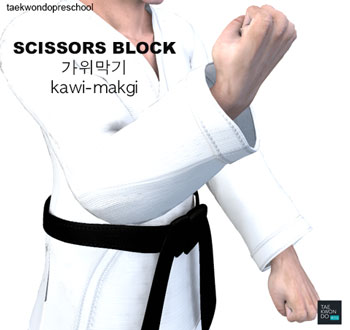


Scissor Block
가위막기 kawi-makgi
Difficulty Level: Advanced Technique: Blocks ( 막기 makgi )
Scissors Block ( 가위막기 kawi-makgi ) is an advanced technique to combination block ( 막기 makgi ) at the same time with a Low Block ( 아래막기 arae makgi ) and an Inner Wrist Outer Block ( 안팔목 바깥막기 anpalmok momtong bakkat magki ). Blocking fists are parallel to the shoulder to keep the defense tight and the palm ( 손바닥 sonbadak ) of the fists should face the body. This intermediate blocking technique is first introduced in World Taekwondo (WT) Taegeuk #7 태극 7장 Chil Jang Poomse.
To begin the technique, the lead forearm is bent and raised to shoulder height, snapping the arm down straight with the palm ( 손바닥 sonbadak ) facing the ground, which blocks ( 막기 makgi ) any incoming low kicks. The other hand uses the inner wrist ( 안팔목 anpalmok ) of your forearm to deflect a strike away from your body. Remember to keep the wrists ( 팔목 palmok ) straight and the arm is angled at 90-120 degrees for the Inner Wrist Outer Block ( 안팔목 바깥막기 anpalmok momtong bakkat magki ).
Typically because of the angles involved, the Scissors Block ( 가위막기 kawi-makgi ) is used to block ( 막기 makgi ) against attacks aimed at the torso. Most critical organs are housed within the torso. For example, in the upper chest, the heart and lungs are protected by the rib cage, while the abdomen contains the stomach, kidney, and etc.
Practitioners may combine techniques in a series to ensure one or more blocks ( 막기 makgi ) impact the strike. These blocks ( 막기 makgi ) are thrown at various areas to protect the practitioner.
Training Methods
How well one improves with training depends on several factors, such as the frequency it is engaged in, and the type of feedback that is available for improvement. If a student does not train often enough, reinforcement fades, and he or she is likely to forget what was learned.
When learning the block ( 막기 makgi ), it is helpful to use mirrors to observe your technique and fix your mistakes immediately. Initially, a student may need focused feedback from a certified Master Instructor ( 사범님 sabeomnim ); however, as they progress, they must develop the ability to self-assess the block ( 막기 makgi ).
The technique is also learned by blocking in the air as though there is an opponent striking but focusing on the form, speed, and technique; then moving on to partner training (self-defence scenarios, sparring practices, one-step sparring, etc) reinforcing the block ( 막기 makgi ) on a realistic moving attack.
In preparation for full contact sparring, students may be required to wait a few months, for safety reasons, because they must first build the skills they would ideally employ in their sparring practice. Some schools restrict the amount of force that may be used to hit an opponent, by allowing 'light contact' during sparring. Light contact allows a student to hit an opponent getting the feel of impacting the opponent but with controlled force and not full power. Light contact sparring is a good method to practice the block ( 막기 makgi ).
Difficulty of Technique
Taekwondo students of geup ranking learn the most basic techniques first, and then move on to more advanced and difficult techniques as they approach 1st Dan Black Belt. The more difficult the technique, the more practice may be needed for the purpose of improving or mastering it, as in the phrase 'practice makes perfect'. Every technique must display the requisite speed, balance, power and firmness to be realistically used as an attack or defense move.
* Please see a certified Master Instructor ( 사범님 sabeomnim ) for training. Proper guidance and instructions are needed to ensure safe training.
Promotion Tests
Students often undergo periodic testing and grading by their own Master Instructor ( 사범님 sabeomnim ) in order to advance to a higher level of recognized achievement such as a different belt color. They need to demonstrate their proficiency in the various aspects of the art such as the execution of patterns ( 품새 poomse ), which combine various techniques in specific sequences.
Scissors Block ( 가위막기 kawi-makgi ) is a requirement for the below belt levels (Techniques vary between schools). Promotion from one belt level to the next can proceed rapidly in some schools, since schools often allow geup promotions every two, three, or four months. Students of geup rank learn the most basic techniques first, and then move on to more advanced techniques as they approach first dan black belt. View Promotion Tests »
Advertisement

Did you know?
Taekwondo Mental Toughness


Mental toughness is very hard to explain through words and can truly be understood when put to the test in an intense situation where you feel like you are at a breaking point, and find an inner will within you to push forward and overcome the situation. There are those who face stressful situations and back down and let them trample them, these people crumble during life. Then there are those who when faced with stressful, energy draining situations take them by the horns and conquer them, and it fills you with such a great energy and confidence, that helps you with every obstacle that you have from there on. For more information View Mental Toughness »
Indomitable spirit ( 백절불굴 baekjul-boolgool ): To have indomitable spirit means to have the courage to stand up for what you believe in, no matter what odds you are up against, and to always give 100% effort in whatever you do.
Self-control ( 극기 geuk-gi ): This means to not only have control over one's physical acts, but also their mental thoughts and actions.
Perseverance ( 인내 in-nae ): One will persevere time and time again until they have achieved a result which is adequate towards what one was trying to achieve.
RESOURCES
This article uses material from the Wikipedia articles "Mental Toughness" and "International Taekwondo Federation Philosophy" which is released under the Creative Commons Attribution-Share-Alike License 3.0.
Scissors Block ( 가위막기 kawi-makgi )
Blocking Surface
Various surfaces of the body may be engaged as the blocking surface depending on which area of the body is being targeted. This leads to a large array of blocking positions. For more information on Impact Surface Areas »
( Click image for additional information)
Technique Injuries
Collisions with the ground, objects, and other taekwondo practitioners are common, and unexpected dynamic forces on limbs and joints can cause injury. Taekwondo injuries can also occur in techniques if done improperly or from overuse of a particular body part. Taking a break from training or reducing the volume and the intensity of the training will allow the body to recover. For more information on Injuries »
( Click image for additional information)
Some Technique(s) to Block Against
Blocking ( 막기 makgi ) is the act of stopping or deflecting an opponent's attack for the purpose of preventing injurious contact with the body in either sparring ( 겨루기 gyeorugi ) or for self-defense ( 호신술 hosinsool ) applications. Experienced practitioners learn through repetition and muscle memory when (not just how) to launch particular blocks ( 막기 makgi ), based on the circumstances they are facing.
( Click image for additional information)
Some Counterstrike Combinations after the Block ( 막기 makgi )
After a successful block ( 막기 makgi ) the taekwondo practitioner may immediately counterattack to the opponent with a kick ( 차기 chagi ) or punch ( 지르기 jireugi ). When the opponent is attacking, they may leave themselves vulnerable in some areas such as recovering from a technique, positioning, imbalance, and more. Practitioners may combine techniques in a series to ensure one or more strikes impact their opponents.
( Click image for additional information)
Some Stance(s) ( 서기 sogi ) used with this Block ( 막기 makgi )
An example of the union of mental and physical discipline is the combination of stance ( 서기 sogi ), footwork ( 딛기 ditgi ), and technique (either with kick, block and/or strike), which requires both physical mastery of the technique and the concentration to focus one's power. Experienced practitioners learn through repetition and muscle memory when (not just how) to launch particular techniques, based on the circumstances they are facing.
( Click image for additional information)
Scissors Block ( 가위막기 kawi-makgi )
Use in Sparring ( 겨루기 gyeorugi )
Under World Taekwondo (WT) and Olympic rules, sparring is a full-contact event and takes place between two competitors in an area measuring 8 meters square. A win can occur by points, or if one competitor is unable to continue (knockout) the other competitor wins. Points are awarded for permitted, accurate, and powerful techniques to the legal scoring areas; light contact does not score any points. For more information on World Taekwondo (WT) Tournament Sparring » 
( Click image for additional information)
Use in Self-Defense ( 호신술 hosinsool ) Applications
Self-Defense is to protect yourself from being attacked from would-be aggressors. It is a countermeasure that involves defending the health and well-being of oneself from harm and is designed primarily to cause injury or quickly incapacitate an attacker, in addition to being a deterrent against them. Attackers are typically larger, stronger, and are often armed or have an accomplice. With proper execution attackers may be incapacitated with a single blow, which lessens the number of attacks with multiple people. For more information on Self-Defense ( 호신술 hosinsool ) »
Each technique must be correctly timed and aligned in order to defend effectively. Taekwondo practitioners must have their body weight correctly distributed during the stance ( 서기 sogi ) including proper footwork ( 딛기 ditgi ). The block ( 막기 makgi ) is performed during Self-Defense ( 호신술 hosinsool ) scenarios.
( Click image for additional information)
Use in One-Step Sparring
One-Step Sparring is performed with a partner in which predefined movements are practiced. One student is the attacker while the other student responds with defenses, counterattacks, and/or other actions, based on part of the predefined movements. For more information on One-Step Sparring »
The block ( 막기 makgi ) is featured during One-Step Sparring practice. Fundamentally, taekwondo One-Step Sparring is one of the learning grounds for real combat. As such, every technique including stance ( 서기 sogi ) must display the requisite speed, power and firmness to be realistically used as an attack or defense move. One-Step Sparring varies between schools.
( Click image for additional information)
Advertisement
Scissors Block ( 가위막기 kawi-makgi )
Use in Patterns ( 품새 poomse )
Block is introduced in the following pattern:
TAEGEUK #: 7
PALGWE #: 5
BLACK BELT: Taebaek 품새 태백 ( 3rd Dan Poomse )
Poomse is the foundation for the teaching of taekwondo. A poomse or form is a detailed pattern of defense-and-attack motions and techniques used in traditional martial arts. Poomse is useful in developing proper kinetics, mental and physical fortitude.
( Click image for additional information)
Most Kukkiwon 국기원 schools will use the poomse taegeuk whereas a few schools will use the poomse palgwe. The meanings, trigrams and symbols are shared by both poomse taegeuk and poomse palgwe, however the sequence of movements is different. The first 8 forms of the set of poomse differ from each other, whereas the last 9 forms (Black Belt forms) of the set are shared between the two sets. All students studying in World Taekwondo (WT) Kukkiwon style must learn these forms, or taegeuk, to advance to a higher belt level. There are eight taegeuk forms, each one similar to the previous one, but each time with more complicated techniques to display the students' mastery of the techniques learned during lessons, as well as the ability to interconnect these techniques.
For more information on taekwondo patterns refer to Poomse 품새 Section »
Learn other taekwondo blocks on the Main Blocking ( 막기 makgi ) Section »
Use in Demonstrations
To promote taekwondo for its emphasis on high kicking and fast hand techniques, taekwondo schools perform at tournaments, community events, shopping malls, parks, and tv shows. Demonstrations vary from school to school, but may include such elements as the execution of poomse ( 품새 poomse ), which combine various techniques in specific sequences; the breaking of boards to demonstrate the ability to use techniques with both power and control; sparring ( 겨루기 gyeorugi ) and self-defense ( 호신술 hosinsool ) to demonstrate the practical application and control of techniques; physical fitness usually with push-ups and sit-ups. For more information on Demonstrations »
The block ( 막기 makgi ) is commonly used in demonstration activities such as when performing poomse ( 품새 poomse ) which is the foundation for the teaching of taekwondo. A poomse ( 품새 poomse ) is a series of movements linked together in a prescribed sequence which is significant to demonstrate. As such, every technique must display the requisite speed, power and firmness to be realistically used as an attack or defense move.
( Click image for additional information)
Use in Warming-Up
A warm-up generally consists of a gradual increase in intensity in physical activity, joint mobility exercise, and stretching, followed by the activity. Warming-up brings the body to a condition at which it safely responds to nerve signals for quick and efficient action. For more information on Warming-Up »
In addition to being a block ( 막기 makgi ) in itself, the block ( 막기 makgi ) is an exercise used by many instructors to teach the principle of focusing, stretching, relaxing the muscles, increasing the range of motion and flexibility, something which is considered important in taekwondo. The result is a feeling of increased muscle control, flexibility and range of motion.
( Click image for additional information)
Scissors Block ( 가위막기 kawi-makgi )
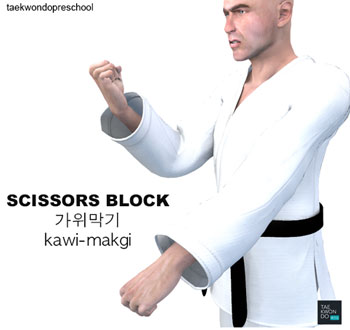

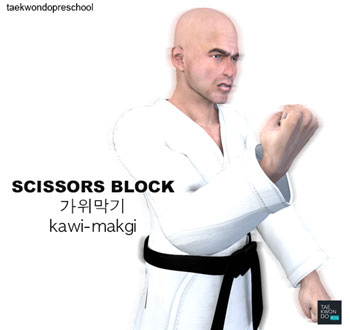

Training Highlights Summary
The Scissors Block ( 가위막기 kawi-makgi ) contains many key point highlights. There are some that are simple and straightforward but then some are complex and detailed that require repeated training to learn and master.
- to block ( 막기 makgi ) at the same time with a Low Block ( 아래막기 arae makgi ) and an Inner Wrist Outer Block ( 안팔목 바깥막기 anpalmok momtong bakkat magki ) against attacks aimed at the torso
- to keep the wrists ( 팔목 palmok ) straight and the arm is angled at 90-120 degrees for the Inner Wrist Outer Block ( 안팔목 바깥막기 anpalmok momtong bakkat magki )
- technique is first introduced in World Taekwondo (WT) Taegeuk #7 태극 7장 Chil Jang Poomse
Precision of Blocking ( 막기 makgi ) Technique
Depending on the strike, one may block ( 막기 makgi ) an attack most commonly by placing a limb across the line of the attack. Some techniques can block and deflect an attack with more precision which allows an effective counterstrike. The below is an approximate measurement of how precise the block requires from the practitioner to be effective.
Experienced practitioners learn through repetition and muscle memory when (not just how) to launch particular blocks ( 막기 makgi ), based on the circumstances they are facing.
* Please see a certified Master Instructor ( 사범님 sabeomnim ) for training. Proper guidance and instructions are needed to ensure safe training.
Additional Resources
Taekwondo Blocks ( 막기 makgi )
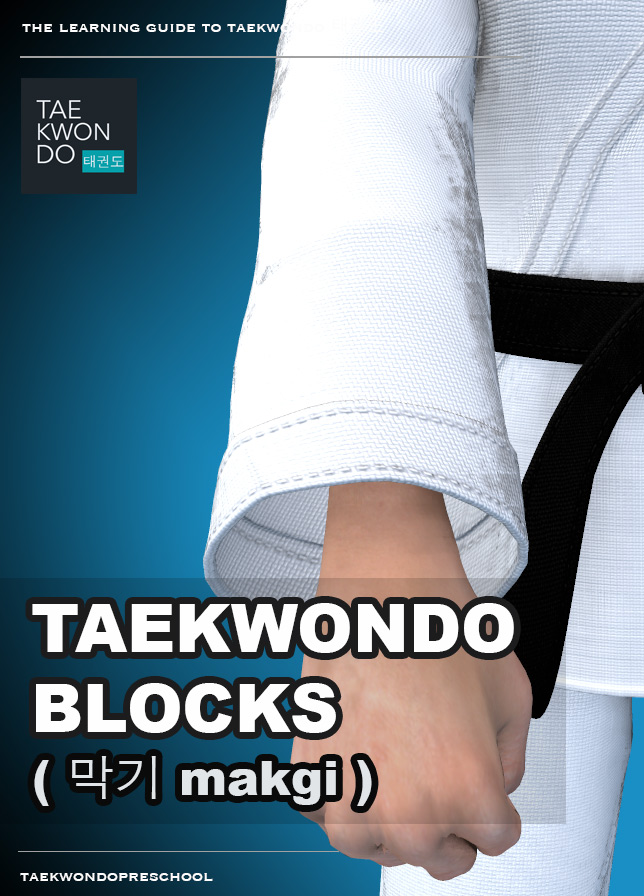
This book is available for download with Apple Books on your Mac or iOS device, and with iTunes on your computer. Book can be read with Apple Books on your Mac or iOS device.
In taekwondo and other martial arts, blocking ( 막기 makgi ) is the act of stopping or deflecting an opponent's attack for the purpose of preventing injurious contact with the body. A block ( 막기 makgi ) usually consists of placing a limb across the line of the attack. Blocks ( 막기 makgi ) are considered by some to be the most direct and least subtle of defensive techniques.
View more information about Book »
TAEKWONDO BLOCKS ( 막기 makgi ) |
|||||
| Hangul 한글 | Korean | Belt Requirement | Difficulty Level | Tutorial | |
| Low Block | 아래막기 | arae-makgi |    |
Beginner Level | Tutorial » |
| Middle Block | 몸통막기 | momtong-makgi |    |
Beginner Level | Tutorial » |
| High Block | 올려막기 | olgul-makgi |    |
Beginner Level | Tutorial » |
| Inner Wrist Outer Block | 안팔목 바깥막기 | anpalmok-bakkat-makgi |   |
Intermediate Level | Tutorial » |
| Single Knife Hand Outward Block | 한손날 바깥막기 | hansonnal-bakkat-makgi |   |
Intermediate Level | Tutorial » |
| Low Side Block | 아래 옆막기 | arae-yeop-makgi |   |
Intermediate Level | Tutorial » |
| Hand Blade Low Block | 한손날 아래막기 | sonnal-arae-makgi |   |
Intermediate Level | Tutorial » |
| Supported Hand Blade Block | 손날 거들어 바깥막기 | sonnal-kodureo-makgi |    |
Intermediate Level | Tutorial » |
| Pressing Block | 눌러막기 | nulleo-makgi |    |
Intermediate Level | Tutorial » |
| Palm Heel Pressing Block | 바탕손 눌러막기 | batangson-nulleo-makgi |    |
Intermediate Level | Tutorial » |
| Outside Wrist Pressing Block | 바깥팔목 눌러막기 | bakkatpalmok-nulleo-makgi |    |
Intermediate Level | Tutorial » |
| Outside Block | 바깥막기 | bakkat-makgi |    |
Intermediate Level | Tutorial » |
| High Outside Block | 올려 바깥막기 | olgul-bakkat-makgi |   |
Intermediate Level | Tutorial » |
| Trunk Push Low Block | 아래 헤쳐막기 | arae-hecho-makgi |  |
Intermediate Level | Tutorial » |
| Cross Block | 엇걸어막기 | otgoreo-makgi |  |
Intermediate Level | Tutorial » |
| Low Cross Blocking | 아래 엇걸어막기 | arae-otgoreo-makgi |  |
Intermediate Level | Tutorial » |
| High Cross Blocking | 올려 엇걸어막기 | olgul-otgoreo-makgi |  |
Intermediate Level | Tutorial » |
| Hand Blade High Cross Block | 손날 엇걸어막기 | sonnal-olgul-otgoreo-makgi |  |
Intermediate Level | Tutorial » |
| Inward Knife Hand Block | 손날 안막기 | sonnal-an-makgi |   |
Intermediate Level | Tutorial » |
| Palm Heel Inward Block | 바탕손 안막기 | batangson-an-makgi |   |
Intermediate Level | Tutorial » |
| Supported Downward Hand Blade Block | 손날 거들어 내려막기 | sonnal-kodureo-naeryeo-makgi |   |
Intermediate Level | Tutorial » |
| Hand Blade Twisting Outward Block | 손날 비틀어 바깥막기 | sonnal-bakkat-bitureo-makgi |   |
Intermediate Level | Tutorial » |
| Palm Heel Assisted Block | 바탕손 거들어 몸통막기 | batangson-kodureo-momtong-makgi |   |
Intermediate Level | Tutorial » |
| Trunk Push Double Block | 헤쳐막기 | hecho-makgi |   |
Intermediate Level | Tutorial » |
| Outside Wrist Double Block | 바깥팔목 헤쳐막기 | bakkat-palmok-hecho-makgi |   |
Intermediate Level | Tutorial » |
| Inside Wrist Double Block | 안팔목 헤쳐막기 | anpalmok-hecho-makgi |   |
Intermediate Level | Tutorial » |
| Side Block | 옆막기 | yeop-makgi |   |
Intermediate Level | Tutorial » |
| Inside Wrist Side Block | 안팔목 옆막기 | anpalmok-yeop-makgi |   |
Intermediate Level | Tutorial » |
| Outside Wrist Side Block | 바깥팔목 옆막기 | bakkat-palmok-yeop-makgi |   |
Intermediate Level | Tutorial » |
| Hand Blade Side Block | 손날 옆막기 | sonnal-yeop-makgi |   |
Intermediate Level | Tutorial » |
| Scissors Blocking | 가위막기 | kawi-makgi |    |
Advanced Level | Tutorial » |
| Supported Trunk Block | 거들어막기 | momtong-kodureo-makgi |  |
Advanced Level | Tutorial » |
| Outside Wrist Supporting Outward Block | 바깥팔목 거들어 바깥막기 | bakkatpalmok-kodureo-bakkat-makgi |  |
Advanced Level | Tutorial » |
| Supported Downward Block | 거들어 내려막기 | kodureo-naeryeo-makgi |  |
Advanced Level | Tutorial » |
| Hand Blade Double Block | 손날 헤쳐막기 | sonnal-hecho-makgi |   |
Advanced Level | Tutorial » |
| Single Hand Wide Open Block | 외산틀막기 | wesanteul-makgi |   |
Advanced Level | Tutorial » |
| Wide Open Mountain Block | 산틀막기 | santeul-makgi |  |
Advanced Level | Tutorial » |
| Diamond Blocking | 금강막기 | keumgang-makgi |  |
Advanced Level | Tutorial » |
| Keumgang Downward Side Block | 금강 내려 옆 막기 | keumgang-naeryeo-yeop-makgi |  |
Advanced Level | |
| Keumgang Outward Block | 금강 바깥막기 | keumgang-bakkat-makgi |  |
Advanced Level | |
| Hand Blade Diamond Downward Side Block | 손날 금강 내려 옆 막기 | sonnal-keumgang-naeryeo-yeop-makgi |  |
Advanced Level | |
| Hand Blade Diamond Outward Block | 손날 금강 바깥막기 | sonnal-keumgang-bakkat-makgi |  |
Advanced Level | |
| Bent Wrist Outward Block | 굽힌손목 바깥막기 | gupinsonmok-bakkat-makgi |  |
Advanced Level | Tutorial » |
| Bull Horn Blocking | 황소막기 | hwangso-makgi |  |
Advanced Level | Tutorial » |
| Ridgehand Outward Block | 손날등 바깥막기 | sonnal-deung-bakkat-makgi |  |
Advanced Level | Tutorial » |
| Ridgehand Side Block | 손날등 옆막기 | sonnal-deung-yeop-makgi |  |
Advanced Level | Tutorial » |
| Ridgehand Double Block | 손날등 헤쳐막기 | sonnal-deung-hecho-makgi |  |
Advanced Level | Tutorial » |
| Ridgehand Supported Downward Block | 손날등 거들어 내려막기 | sonnal-deung-kodureo-naeryeo-makgi |  |
Advanced Level | Tutorial » |
| Inner Wrist Supporting Side Block | 안팔목 거들어 옆막기 | anpalmok-kodureo-yeop-makgi |  |
Advanced Level | Tutorial » |
| Inner Wrist Supporting Outward Block | 안팔목 거들어 바깥막기 | anpalmok-kodureo-bakkat-makgi |  |
Advanced Level | Tutorial » |
| Palm Assisting Outer Block | 손바닥 거들어 바깥막기 | sonbadak-kodureo-bakkat-makgi |  |
Advanced Level | Tutorial » |
| Target Block | 표적 막기 | pyojeok-makgi |  |
Advanced Level | Tutorial » |
| Underneath Target Block | 아래 표적 막기 | arae-pyojeok-makgi |  |
Advanced Level | Tutorial » |
| Kicking Block | 차막기 | cha-makgi |  |
Advanced Level | Tutorial » |
| Outward Kicking Block | 바깥 차막기 | bakkat-cha-makgi |  |
Advanced Level | Tutorial » |
| Inward Kicking Block | 안 차막기 | an-cha-makgi |  |
Advanced Level | Tutorial » |
| Front Kicking Block | 앞 차막기 | ap-cha-makgi |  |
Advanced Level | Tutorial » |
| Side Kicking Block | 옆 차막기 | yeop-cha-makgi |  |
Advanced Level | Tutorial » |
Advertisement

Quiz
Question. What is the korean terminology for Front Stance?
Front Stance is a precursor of the fighting stance ( 겨루기준비 gyeorugi-junbi ) according to some authors. Body should be relaxed in this stance ( 서기 sogi ). From the attention stance ( 차렷 charyeot ) with feet together, one foot is placed straight ahead of the other. Depending on the martial art and style, some instructors teach to step sideways slightly when moving forward.
Question. What is the korean terminology for Front Stance?
Answer you gave was: ( 뒷굽이 dwi kubi )
Your answer is wrong! You need to study more!
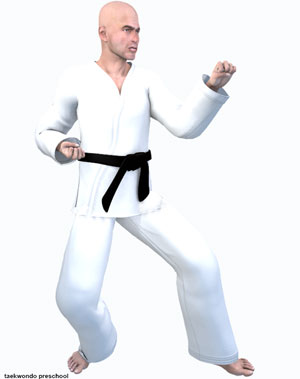
Back Stance ( 뒷굽이 dwi kubi ) is specifically focused on shifting weight to the back leg, as it offers much more control, and makes it easier to kick off the front leg. To perform the Back Stance ( 뒷굽이 dwi-kubi ), the body faces to the side, with the front foot facing forward and the front leg bent. The back leg is bent slightly and the foot is turned outwards perpendicular to the front foot making the letter "L" for this stance ( 서기 sogi ).
Question. What is the korean terminology for Front Stance?
Answer you gave was: ( 주춤서기 juchum sogi )
Your answer is wrong! You need to study more!

The Horse-Riding Stance ( 주춤서기 juchum-sogi ) is a beginner stance ( 서기 sogi ) generally used to practice punches ( 지르기 jireugi ) and blocks ( 막기 makgi ). It is similar to the Ready Stance ( 기본준비 junbi ) but the feet are placed much wider, about two-foot length's apart. Also, the knees ( 무릎 mureup ) are deeply bent and the shins ( 정강이 jeonggangi ) should be kept slightly perpendicular to the floor.
Question. What is the korean terminology for Front Stance?
Answer you gave was: ( 앞굽이 ap kubi )
Your answer is correct! Great Job!

Front Stance ( 앞굽이 ap-kubi ) is one of the most important techniques to learn when starting taekwondo as a beginner. The distance between the inside edges or namely the Reverse Foot Blade ( 발날등 balnaldeung ) of both feet should be between one to two fists apart and is about 4 to 4 one-half foot-length from origin. Rear toes are turned outward about 30 degrees and the body is also naturally angled at 30 degrees or facing straight forward depending on the upper body technique.
Question. What is the korean terminology for Front Stance?
Answer you gave was: ( 앞서기 ap sogi )
Your answer is wrong! You need to study more!

The Walking Stance ( 앞서기 ap-sogi ) is a beginner stance ( 서기 sogi ) that is used to approach or retreat in combat and patterns ( 품새 poomse ). Feet should be maintained approximately 3 foot-length from origin. To maintain a solid base, the front foot is facing straight forward and the back foot is 30 degrees to aid balance. Use of this stance ( 서기 sogi ) is featured prominently in many of the World Taekwondo (WT) Poomse.
Question. What is the name of Taegeuk #2 in Korean?
Taegeuk 태극 (in World Taekwondo (WT)) refers to a set of poomse 품새 used to create a foundation for the teaching of taekwondo. A poomse or form is a detailed pattern of defense-and-attack motions and techniques used in traditional martial arts. Each taegeuk form symbolizes a specific state thought to be indicative of the belt the student currently holds, and is represented in World Taekwondo (WT) by trigrams similar to those found in the four corners of the South Korean flag.
Question. What is the name of Taegeuk #2 in Korean?
Answer you gave was: Yi Jang
Your answer is correct! Great Job!


The associated trigram of this poomse represents the Lake. Also, related to the symbol is South East and the relationship of the youngest daughter. The movements of this Taegeuk are aimed to be performed believing that man has limitations, but that we can overcome these limitations. The Lake and its water symbolize the flowing and calm nature of the martial artist.
Question. What is the name of Taegeuk #2 in Korean?
Answer you gave was: Sam Jang
Your answer is wrong! You need to study more!


This trigram represents Fire. Related to this symbol is also East and the relationship of the Second Daughter. Fire contains a lot of energy. The symbol behind the fire is similar to the symbolism of the water in that both can aid and both can destroy. This form is intended to be performed rhythmically, with some outbursts of energy to reflect fire's rhythmic and energetic dualism.
Question. What is the name of Taegeuk #2 in Korean?
Answer you gave was: Il Jang
Your answer is wrong! You need to study more!


The general meaning of this form and associated trigram is Yang, which represents Heaven and Light. Also, this trigram has a relationship to South and Father. The first Taegeuk form is the beginning of all poomses, the "birth" of the martial artist into Taekwondo. This poomse should be performed with the greatness of Heaven.
Question. What is the name of Taegeuk #2 in Korean?
Answer you gave was: Chil Jang
Your answer is wrong! You need to study more!


The trigram associated with this poomse represents a Mountain. Also, it represents the northwest and youngest son. The symbolism behind the mountain is the indomitable and majestic nature that all mountains possess. This poomse is intended to be performed with the feeling that all movements are this majestic due to their unconquerable nature.
Question. What is the korean terminology for Ready Stance?
Ready Stance refers to the most common ready position used in taekwondo training. The stance ( 서기 sogi ) is performed by standing with the feet one foot-length from origin apart, measured from the inside edge or namely the Reverse Foot Blade ( 발날등 balnaldeung ) of the feet. The arms are slightly bent and the fists held tightly about one fist size apart just below the belly button and the fists should be a fist size away from the body.
Question. What is the korean terminology for Ready Stance?
Answer you gave was: ( 주춤서기 juchum sogi )
Your answer is wrong! You need to study more!

The Horse-Riding Stance ( 주춤서기 juchum-sogi ) is a beginner stance ( 서기 sogi ) generally used to practice punches ( 지르기 jireugi ) and blocks ( 막기 makgi ). It is similar to the Ready Stance ( 기본준비 junbi ) but the feet are placed much wider, about two-foot length's apart. Also, the knees ( 무릎 mureup ) are deeply bent and the shins ( 정강이 jeonggangi ) should be kept slightly perpendicular to the floor.
Question. What is the korean terminology for Ready Stance?
Answer you gave was: ( 기본준비 junbi )
Your answer is correct! Great Job!

Ready Stance ( 기본준비 junbi ) is performed by standing with the feet one foot-length from origin apart, measured from the inside edge or namely the Reverse Foot Blade ( 발날등 balnaldeung ) of the feet. The arms are slightly bent and the fists held tightly about one fist size apart just below the belly button and the fists should be a fist size away from the body. The stance ( 서기 sogi ) is one of the most important techniques to learn when starting taekwondo as a beginner.
Question. What is the korean terminology for Ready Stance?
Answer you gave was: ( 앞굽이 ap kubi )
Your answer is wrong! You need to study more!

Front Stance ( 앞굽이 ap-kubi ) is one of the most important techniques to learn when starting taekwondo as a beginner. The distance between the inside edges or namely the Reverse Foot Blade ( 발날등 balnaldeung ) of both feet should be between one to two fists apart and is about 4 to 4 one-half foot-length from origin. Rear toes are turned outward about 30 degrees and the body is also naturally angled at 30 degrees or facing straight forward depending on the upper body technique.
Question. What is the korean terminology for Ready Stance?
Answer you gave was: ( 앞서기 ap sogi )
Your answer is wrong! You need to study more!

The Walking Stance ( 앞서기 ap-sogi ) is a beginner stance ( 서기 sogi ) that is used to approach or retreat in combat and patterns ( 품새 poomse ). Feet should be maintained approximately 3 foot-length from origin. To maintain a solid base, the front foot is facing straight forward and the back foot is 30 degrees to aid balance. Use of this stance ( 서기 sogi ) is featured prominently in many of the World Taekwondo (WT) Poomse.
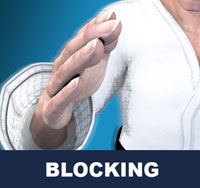

Related Information
In martial arts, blocking ( 막기 makgi ) is the act of stopping or deflecting an opponent's attack for the purpose of preventing injurious contact with the body. A block ( 막기 makgi ) usually consists of placing a limb across the line of the attack. Blocks ( 막기 makgi ) are considered by some to be the most direct and least subtle of defensive techniques. Other ways of avoiding attack include evasion, trapping, slipping and deflection of the oncoming attack; this approach is often referred to as the application of 'soft' techniques.
View all taekwondo blocks on the Blocks ( 막기 makgi ) Main Section »
- Low Block ( 아래막기 arae-makgi )
- Middle Block ( 몸통막기 momtong-makgi )
- High Block ( 올려막기 olgul-makgi )
- Outside Block ( 바깥막기 momtong-bakkat-makgi )
- High Outside Block ( 올려 바깥막기 olgul-bakkat-makgi )
- Single Knife Hand Outward Block ( 한손날 바깥막기 hansonnal-bakkat-makgi )
- Inward Knife Hand Block ( 손날 안막기 sonnal-an-makgi )
- Hand Blade Low Block ( 한손날 아래막기 sonnal-arae-makgi )
- Hand Blade Twist Outward Block ( 손날 비틀어 바깥막기 sonnal-bitureo-bakkat-makgi )
- Pressing Block ( 눌러막기 nulleo-makgi )
- Palm Heel Pressing Block ( 바탕손 눌러막기 batangson-nulleo-makgi )
- Palm Heel Inward Block ( 바탕손 안막기 batangson-an-makgi )
- Palm Heel Assisted Block ( 바탕손 거들어 몸통막기 batangson-kodureo-momtong-makgi )
- Cross Block ( 엇걸어막기 otgoreo-makgi )
- Low Cross Block ( 아래 엇걸어막기 arae-otgoreo-makgi )
- High Cross Blocking ( 올려 엇걸어막기 olgul-otgoreo-makgi )
- Knife Hand High Cross Block ( 손날 엇걸어막기 sonnal-olgul-otgoreo-makgi )
- Inner Wrist Outer Block ( 안팔목 바깥막기 anpalmok-bakkat-makgi )
- Trunk Push Double Block ( 헤쳐막기 hecho-makgi )
- Trunk Push Low Block ( 아래 헤쳐막기 arae-hecho-makgi )
- Outside Wrist Double Block ( 바깥팔목 헤쳐막기 bakkat-palmok-hecho-makgi )
- Inside Wrist Double Block ( 안팔목 헤쳐막기 anpalmok-hecho-makgi )
- Hand Blade Double Block ( 손날 헤쳐막기 sonnal-hecho-makgi )
- Ridgehand Double Block ( 손날등 헤쳐막기 sonnal-deung-hecho-makgi )
- Outside Wrist Pressing Block ( 바깥팔목 눌러막기 bakkatpalmok-nulleo-makgi )
- Bent Wrist Outward Block ( 굽힌손목 바깥막기 gupinsonmok-bakkat-makgi )
- Kicking Block ( 차막기 cha-makgi )
- Outward Kicking Block ( 바깥 차막기 bakkat-cha-makgi )
- Inward Kicking Block ( 안 차막기 an-cha-makgi )
- Front Kicking Block ( 앞 차막기 ap-cha-makgi )
- Side Kicking Block ( 옆 차막기 yeop-cha-makgi )
- Wide Open Mountain Block ( 산틀막기 santeul-makgi )
- Single Hand Wide Open Block ( 외산틀막기 wesanteul-makgi )
- Bull Horn Block ( 황소막기 hwangso-makgi )
- Scissors Block ( 가위막기 kawi-makgi )
- Diamond Block ( 금강막기 keumgang-makgi )
- Keumgang Downward Side Block ( 금강 내려 옆 막기 keumgang-naeryeo-yeop-makgi )
- Keumgang Outward Block ( 금강 바깥막기 keumgang-bakkat-makgi )
- Hand Blade Diamond Downward Side Block ( 손날 금강 내려 옆 막기 sonnal-keumgang-naeryeo-yeop-makgi )
- Hand Blade Diamond Outward Block ( 손날 금강 바깥막기 sonnal-keumgang-bakkat-makgi )
- Supported Trunk Block ( 거들어막기 momtong-kodureo-makgi )
- Supported Hand Blade Block ( 손날 거들어 바깥막기 sonnal-kodureo-makgi )
- Supported Downward Hand Blade Block ( 손날 거들어 내려막기 sonnal-kodureo-naeryeo-makgi )
- Outside Wrist Supported Trunk Block ( 바깥팔목 거들어 바깥막기 bakkatpalmok-kodureo-bakkat-makgi )
- Supported Downward Block ( 거들어 내려막기 kodureo-naeryeo-makgi )
- Ridgehand Outward Block ( 손날등 바깥막기 sonnal-deung-bakkat-makgi )
- Ridgehand Supporting Downward Block ( 손날등 거들어 내려막기 sonnal-deung-kodureo-naeryeo-makgi )
- Side Block ( 옆막기 yeop-makgi )
- Low Side Block ( 아래 옆막기 arae-yeop-makgi )
- Inside Wrist Side Block ( 안팔목 옆막기 anpalmok-yeop-makgi )
- Outside Wrist Side Block ( 바깥팔목 옆막기 bakkat-palmok-yeop-makgi )
- Ridgehand Side Block ( 손날등 옆막기 sonnal-deung-yeop-makgi )
- Hand Blade Side Block ( 손날 옆막기 sonnal-yeop-makgi )
- Inner Wrist Supporting Side Block ( 안팔목 거들어 옆막기 anpalmok-kodureo-yeop-makgi )
- Inner Wrist Supporting Outward Block ( 안팔목 거들어 바깥막기 anpalmok-kodureo-bakkat-makgi )
- Palm Assisting Outer Block ( 손바닥 거들어 바깥막기 sonbadak-kodureo-bakkat-makgi )
- Target Block ( 표적 막기 pyojeok-makgi )
- Underneath Target Block ( 아래 표적 막기 arae-pyojeok-makgi )
There are five tenets defined in the International Taekwondo Federation (ITF) and several more in World Taekwondo (WT).
Courtesy ( 예의 ye-ui ): "Showing courtesy to all, respecting others, having manners as well as maintaining the appropriate etiquette at all times, both within and outside the dojang (도장) (designated training area)." View Taekwondo Tenets »
RESOURCES
This article uses material from the Wikipedia article "List of Taekwondo Techniques", which is released under the Creative Commons Attribution-Share-Alike License 3.0.








